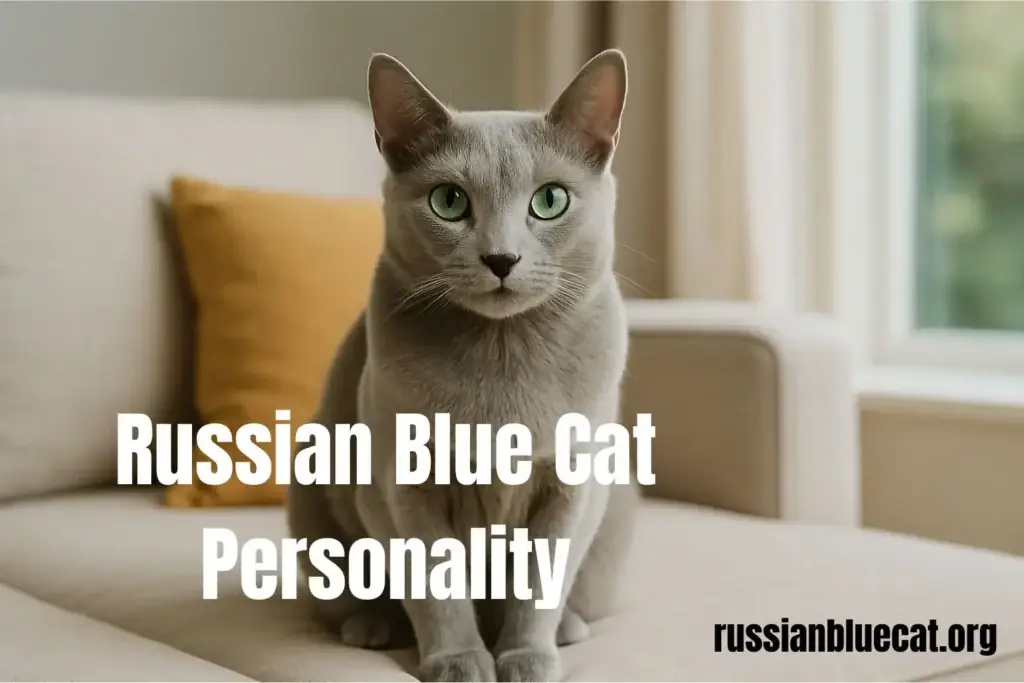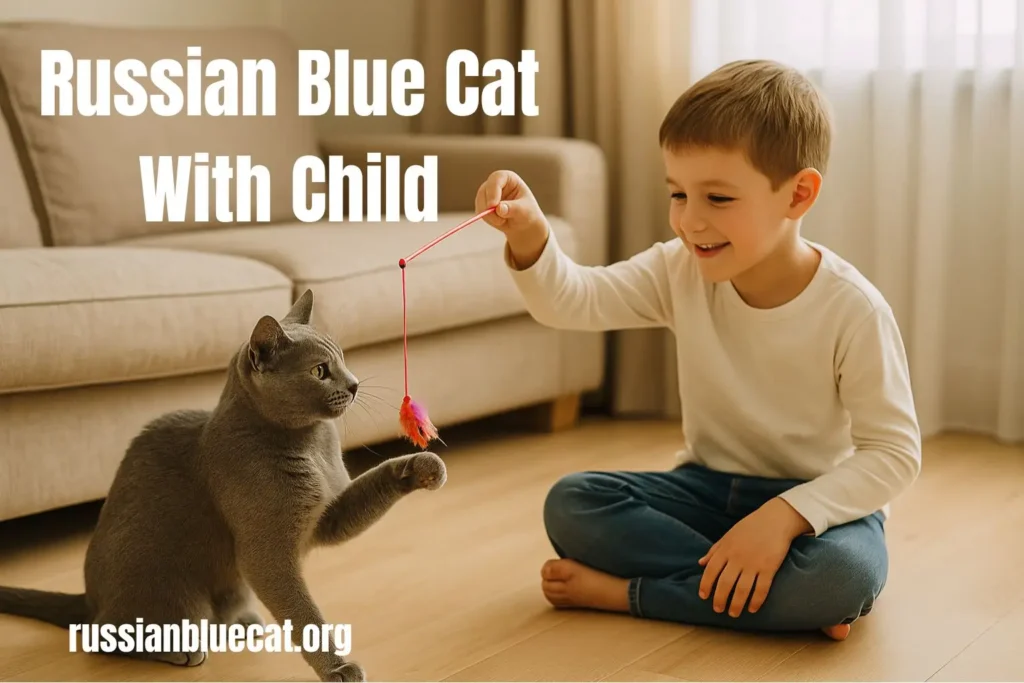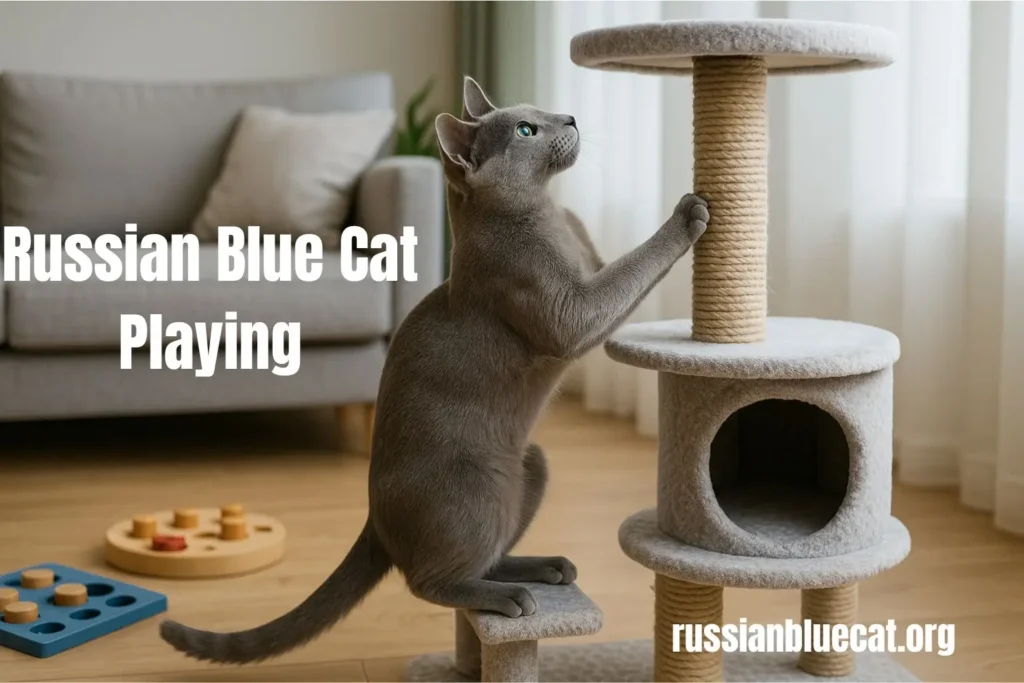The Truth About Russian Blue Cat Personality: 7 Secrets Revealed in 2025

Introduction: Beyond the Silver-Blue Fur
The Russian Blue Cat is usually first noticed for its glimmering blue-gray fur and mesmerizing emerald eyes. But ask any owner, and they’ll all tell you that the Russian Blue Cat personality is what makes this breed irreplaceable.
Why is personality so important? Because adopting a pet isn’t just about looks it’s about whether that cat’s temperament fits your lifestyle. Russian Blues can live up to 20 years. If you’re looking for a loyal, quiet, and intelligent companion, this breed may be the perfect choice.
History of the Breed and Its Influence on Personality

The origins of the Russian Blue explain much about its personality today.
- Cold Climate Survivors: From Arkhangelsk, Russia, they developed thick coats and self-sufficiency, qualities which resonate through their independence.
- Seafaring Companions: Sailors supposedly took them on board ships, confirming adaptability as well as devotion.
- European Aristocracy: In the late 19th century, they were cherished pets of the English aristocracy, valued for their elegant refinement and placid nature.
Their past of enduring challenging surroundings and forming a connection with humans has led to the Russian Blue Cat personality becoming one of resilience and loyalty. Have you checked our detailed guide on Russian Blue Domestic Cat.
General Temperament

Three words describe the Russian Blue Cat personality: loyal, intelligent, reserved.
- Quiet Nature: They are not as talkative as Siamese cats. They prefer instead to emit low, soothing meows or silent trills when they really do need attention.
- Keen Intelligence: They’re problem solvers, frequently learning to open cupboards or recalling feeding times with almost supernatural accuracy.
- Respectful Reserve: They’re initially wary, sometimes taking time to get to know them, but once they feel safe, their allegiance is lifelong.
- Faithful Companionship: Russian Blues form strong bonds, frequently selecting one human as their favorite, although they are affectionate to the entire family.
Real-Life Example: Russian Blues, numerous owners report, don’t simply sit on their lap—rather, they trail behind them like a shadow, silently keeping them company and occupying the same space.
Russian Blue with Family
With Children

Russian Blues get along great with children who are gentle and respectful. They won’t put up with rough tugging or chasing but love children who play gently.
Tip: In households with toddlers, give them safe places to hide so that the cat feels safe.
With Adults
They’re ideal companions for adults who crave attention without incessant demands. If you reside alone, be prepared for your Russian Blue to become your faithful shadow. They’re also favorites of couples as they bond with both partners but tend to choose one “favorite.”
With Strangers
The reserved nature of the Russian Blue Cat temperament manifests here. New visitors might never catch sight of your cat on the initial visit. But with time and tolerance, Russian Blues will observe in silence, spying from afar before deciding whether they’ll approach.
Affection Level
How affectionate are Russian Blues?
- Cuddling Style: They are not lap cats twenty-four/seven, but they’ll be sitting near you, leaning against you, or just generally rubbing up against you and curling up at your feet.
- Shadow Companionship: They trail after their humans in silence, always near but never clingy.
- Balanced Affection: They’re affectionate without smothering you—perfect for someone who desires affection but not constant attention.
Owner Insight: One Russian Blue owner shared: “She isn’t clingy, but when I’m sad, she somehow knows and curls up beside me. It feels like emotional support.”
Compatibility with Other Pets
The Russian Blue Cat personality adapts well to multi-pet households—with proper introductions.
- With Dogs: Calm, respectful dogs make good companions. Hyperactive breeds may stress them.
- With Cats: They enjoy feline company, especially if the other cat is equally calm.
- Best Practice: Gradually introduce with scent exchange, followed by gradual face-to-face contact.
Russian Blues are not confrontational. They would rather have harmony and will withdraw if tension is present.
Training and Activity Needs

The intelligence of the breed ensures that training is a pleasure.
Training Potential
- Litter Box: Learned in days.
- Clicker Training: Good response to rewards.
- Tricks: Can be trained to fetch, sit, high-five, and walk on leash.
Activity Preferences
- Playtime: Feather wands, laser toys, and interactive puzzle toys keep them stimulated.
- Mental Stimulation: Puzzle feeders are great for their problem-solving stimulus.
- Environment: Window perches and cat trees enable them to watch their world safely.
Pro Tip: Russian Blues are fond of routines. Play at the same time every day to keep them mentally content.
Emotional Sensitivity
An interesting part of the Russian Blue Cat personality is emotional intelligence.
- Routine Lovers: Abrupt changes in schedule or surroundings might stress them.
- Emotional Awareness: Owners describe their Russian Blue as appearing to know when they’re upset or stressed and responding with gentle comfort.
- Separation Anxiety: They tolerate alone time, but prolonged absence can stress them. Leaving toys and warm areas minimizes the issue.
Section 7: Health and Longevity

Russian Blues are generally healthy, but personality may change if health is not ensured.
- Lifespan: 15–20 years with proper care.
- Common Issues:
- Obesity: Portion control is essential.
- Dental Care: Brush teeth or dental treats.
- Heart Disease: Certain may get hypertrophic cardiomyopathy (HCM).
- Urinary Issues: Diet and hydration are key.
👉 For full details, go to our Russian Blue Cat Health Guide.
Section 8: Russian Blue vs Other Breeds
| Breed | Personality | Vocal Level | Energy | Best Fit |
|---|---|---|---|---|
| Russian Blue | Loyal, quiet, smart | Quiet | Moderate | Families, singles, apartments |
| Siamese | Social, demanding | Very high | High | Owners home often |
| British Shorthair | Casual, easygoing | Low | Low–Moderate | Families, seniors |
| Maine Coon | Sociable, playful | Moderate | High | Families with large homes |
| Bengal | Energetic, adventurous | Moderate | Very high | Experienced, active owners |
This table illustrates why the Russian Blue Cat personality is sometimes referred to as “balanced”—cuddly but not overly so.
Section 9: Adoption and Buying
In choosing a Russian Blue, personality compatibility is the most important factor.
- Adoption: Inexpensive ($100–$300), and most Russian Blue mixes have the same temperament.
- Buying from Breeders: Pedigree kittens are $800–$2,000. Carefully select ethical breeders.
- Ideal Owners: Quiet households, singles, and first-time owners who appreciate affection without commotion.
For official breed standards, go to the Cat Fanciers’ Association (CFA).
Section 10: Cost of Ownership
A Russian Blue is a monetary investment.
- Initial Costs: Adoption fee or breeder cost, with an additional $150–$300 for items.
- Annual Costs:
- Food & Treats: $300–$600
- Litter: $200–$400
- Vet Care: $150–$300
- Insurance: $250–$500
- Toys & Accessories: $100–$250
Annual Total: $700–$1,200, excluding emergencies.
FAQs
Conclusion
The Russian Blue Cat personality is one of loyalty, calm affection, and intelligence. They’re reserved with strangers, playful with family, and deeply devoted to their chosen humans. Perfect for families, singles, or first-time cat owners, they strike a rare balance between affection and independence.
If you’re looking for a long-term companion with grace, loyalty, and emotional depth, the Russian Blue is an excellent choice.






